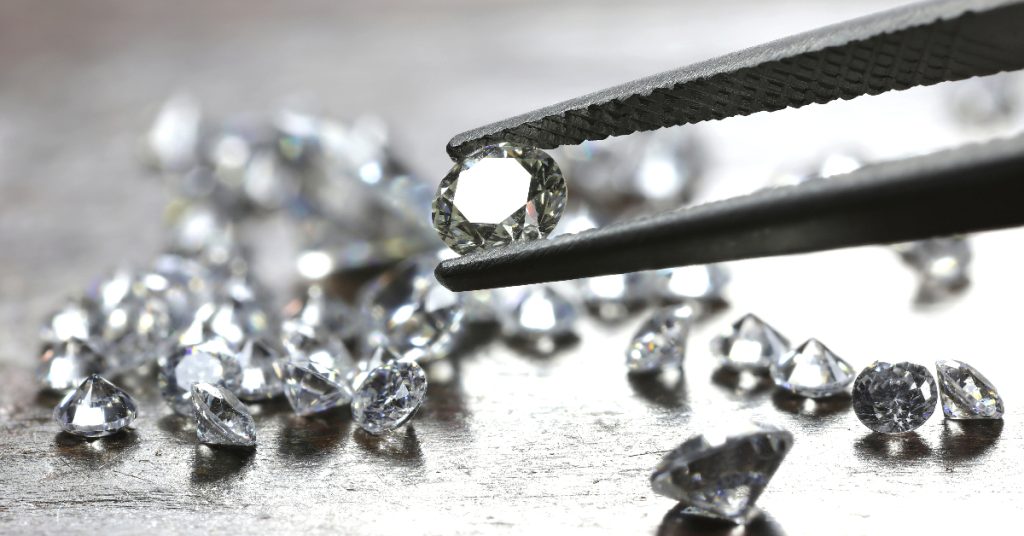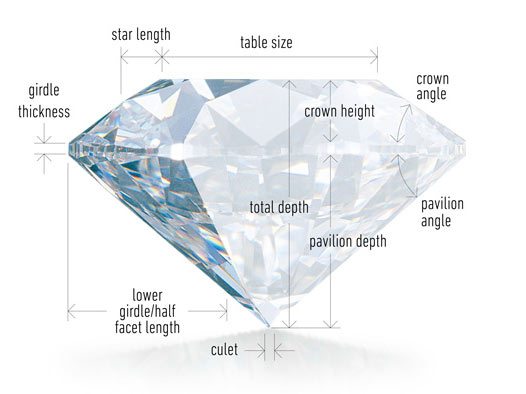Diamond Buying Guide

The 4 C’s and How to Buy a Diamond Ring with Confidence
If you’re in the lucky position of thinking about buying a diamond ring, it can be hard to know where to start. After all, you can’t become a diamond expert overnight. However, with a bit of background knowledge you can start to make more informed choices about which diamond characteristics are the most important to you. In this Diamond Buying Guide, we look at each of the ‘4 C’s’ and discover how they come together to determine the quality and value of a diamond. Also, we look at the most popular diamond shapes. Finally, we think about how to achieve what we at Zelley call the fifth C – confidence! It’s important to feel confident about your diamond and with our expert help, we show you how.
The 4 C’s: Cut, Clarity, Colour and Carat
The 4 C’s refer to the four main factors that determine the beauty, quality, and value of a diamond: Cut, Clarity, Colour and Carat. Created by the Gemmological Institute of America (GIA), they have become the universal standard for assessing diamonds. Let’s look at each one in turn.
1 – Diamond Cut
The Cut of the diamond has the greatest influence on how much it sparkles. Not to be confused with overall shape, the Cut refers to the tiny facets that are polished into a rough stone to turn it into a sparkling diamond. A well-cut diamond has proportioned facets that allow light to be dispersed and reflected from one facet to another. This releases the diamond’s scintillation, fire, and brilliance (see below). The quality of the cut is determined by proportion, symmetry and how the diamond is polished.
Even if a diamond has a high clarity and colour grade, with a poor cut it will appear dull.
What is the difference between Brilliance, Scintillation and Fire?
Brilliance is a measure of the proportion of light which enters a diamond and is reflected back to the eye through the top of the stone.
Scintillation or ‘sparkle’ refers to the play of light you see with movement of the diamond. It is a measure of how well light reflects off the top facets.
Fire or ‘dispersion’ refers to the rainbow of colours reflected back to the eye from the diamond. When light enters the top of the diamond, it is refracted, splitting the light into this rainbow of colours, and is reflected back and forth off the mirror-like facets.
Anatomy of a Diamond: Facet Names
A diamond cut is made up of the following types of facets.
- Table: The large central facet on the top of the diamond. The table is essential to how much the diamond sparkles
- Crown: The upper part of a diamond between the girdle and the table. It is made up of star facets, bezel facets and the upper girdle
- Girdle: The thin perimeter that divides the crown from the pavilion.
- Pavilion: The bottom half of a diamond. The facets within the pavilion help light bounce, enter, and reflect through the stone
- Lower girdle: Lower girdle facets sit below the girdle and next to the pavilion. They help reflect light in different directions
- Cutlet: The flat face where the facets of the pavilion meet
Image credit: https://4cs.gia.edu/en-us/diamond-cut/
How does pavilion depth affect a diamond’s cut?
If a diamond is cut too shallow or too deep, it will allow light to leak out from the side of the stone or the bottom. A well-cut stone directs more light through the crown.
Choosing a well-cut diamond
It is the balance between each facet that equates to the best diamond cut. At Zelley we hand-pick every single diamond for its quality and value. Only the best cuts are selected for our diamond rings.
2 – Diamond Clarity
Clarity refers to the absence of inclusions and blemishes in a diamond. Diamonds are exposed to huge heat and pressure as they form under the earth. This results in unique internal characteristics called inclusions and external characteristics called blemishes. Although inclusions are natural, they disrupt the passage of light through the diamond, and this affects the sparkle. The GIA ranks diamond clarity on a scale with 11 specific grades. However, it’s important to understand that many inclusions and blemishes are invisible to the naked eye. A VS1 and SI2 diamond may look the same to the naked eye but the difference in clarity makes them quite different in terms of quality.
Clarity is determined by the size, number, location, orientation, nature, and overall visibility of the inclusions. When gemmologists inspect diamonds for clarity, they use a single lens 10x magnifying glass (a loupe) and judge the visibility of inclusions from the top of the diamond.
Image credit: https://4cs.gia.edu/en-us/diamond-clarity/
3 – Diamond Colour
The colour of a diamond is a measure of how colourless or “white” it is. The GIA grades diamond colour on a scale of D (colourless) to Z (light yellow or brown). Differences in colour are subtle and it is often difficult for the untrained eye to distinguish between grades that are close together. However, as with clarity, differences in colour affect the quality and therefore the value of a diamond.

Image credit: https://4cs.gia.edu/en-us/diamond-colour/
4 – Diamond Carat
Diamond Carat Weight measures the apparent size of a diamond i.e., how much it weighs. A metric “carat” is defined as 200 milligrams. Each carat is subdivided into 100 ‘points.’ Under a carat, a jeweller may refer to the weight of the diamond using points alone. Therefore a 0.25ct diamond could be referred to as ’25 points’. Above a carat, diamond weights are expressed in carats and decimals.
12 carat diamond – 50 point or 0.50 carat diamond
14 carat diamond – 25 point or 0.25 carat diamond
Diamond price increases with carat weight. Therefore, if there are two diamonds with identical cut, clarity and colour, the diamond with the greatest carat weight will have a higher value. However, because all 4 C’s are important, it’s crucial to remember that with diamonds, size isn’t everything.
Using the 4 C’s to choose the diamond that’s ring for you
In an ideal world, you would choose a diamond with the highest grade of all 4 C’s. However, since most of us have a limited budget, it’s a good idea to consider which of the C’s are the most important to you. If you want maximum sparkle, then cut and clarity should be your focus. However, if making a visual impact is your priority, then carat will take precedence over the other 3 C’s.
Guide to Diamond Shape
Shape is a really important factor to think about when choosing a diamond, particularly for an engagement ring. The shape of the diamond refers to the outline (not to be confused with the cut which refers to the facets, symmetry, and reflective properties as described above). Some shapes are more economical than others (as there is less wastage when the diamond is cut) so choosing them can result in greater visual impact. Others are shaped the way they are for maximum refraction and reflection of light. Here are the 6 most popular diamond shapes you should know about: –
Round Brilliant Cut
A Round Brilliant Cut Diamond is the most popular choice for engagement rings. The stone is cut in the shape of a cone with the top rounded off. This allows it to return the light that enters it, making it the most brilliant of all the available cuts. However, round cut diamonds do cost more than other diamond shapes because the most raw material is lost when they are shaped.
Oval Cut
An Oval Cut Diamond offers a beautiful twist on the round brilliant cut for a vintage-inspired look. Like the round brilliant cut, the oval diamond usually has 58 facets in a symmetrical cut that maximises the stone’s brilliance. The oval shape maximises its carat weight so it can appear larger than round stones of a similar carat.
Princess Cut
Square in shape, a Princess Cut Diamond is a contemporary choice and looks fantastic as a solitaire in an engagement ring. A modified version of the round brilliant cut, it has 57 or 76 facets. A pyramid shape, it has four bevelled sides which accentuate the diamond’s fire and brilliance. It is the most brilliant of all square and rectangular-shaped diamonds. The cost of a Princess Cut is high compared with other shapes.
Emerald Cut
Emerald Cut Diamonds have a rectangular shape with cropped corners. While it tends to have less brilliance and fire than brilliant cuts, the long facets of an emerald cut diamond will highlight the clarity of the stone. Emerald shaped diamonds are one of the most economical of all the shapes. Therefore, if you have any budget left, it’s good idea to spend more on a higher clarity grade as imperfections are easily spotted.
Marquise
With its elongated shape, a Marquise Diamond looks visually larger. Also, it has the added benefit of making fingers appear longer and more slender. Ensure the setting protects the tips of the stone to prevent chipping.
Pear Shape
Also known as teardrop, the Pear Shape Diamond has a brilliant cut which optimises light reflection and combines the shape of an oval and marquise diamond. Like the Marquise, it has a slimming effect on the ring finger.
The Zelley Experience and the ‘5th C’: Confidence
Whether you have an idea of the diamond ring you’re looking for or are yet to be inspired, we’re here to help. As a fourth-generation family business, we have over 100 years of experience in helping couples choose the perfect engagement ring. Therefore, you can be confident that you’re in safe hands.
We have an unrivalled selection of hand-picked diamond rings for you to view. Alternatively, if you want to be creative and design your own ring, our in-house CAD designer can help you bring your dream ring to life.
Arrange a no-obligation consultation with us at a time that suits you. We’ll answer your questions, make you feel completely at ease and ensure you have a special, unforgettable experience. We call this “The Zelley Experience”. At Zelley we go the extra mile to make you feel special. If there’s a type of champagne you love, let us know and it will be on ice for your arrival. Maybe there’s a song that means a lot to you both? If you tell us in advance, we’ll have it playing in the background. If there are any special touches we can add to tailor your consultation, all you need do is say! At Zelley, we always rise the occasion and love being part of your wedding story.







